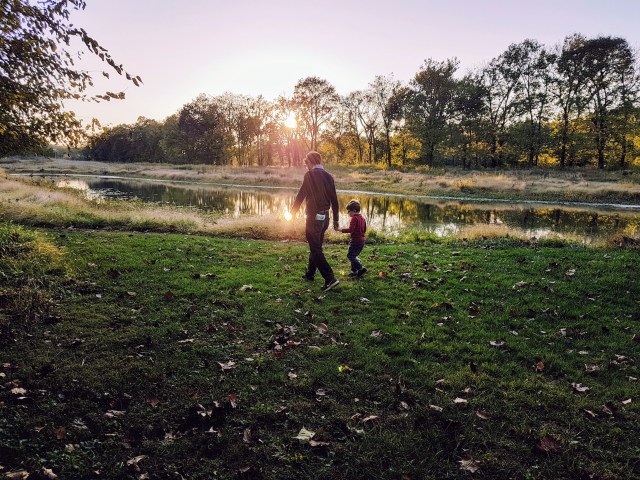Our series, Family Tales, is an honest peek into the daily lives of families across the country who are on this crazy ride we call parenthood! From divulging childcare costs to breaking down family finances to managing a virtual school year with multiple kids, we tap into the Red Tricycle army of parents to find out how they’re making it work. This series is a judgment-free zone.
Interested in telling your story? Start by filling out our questionnaire here. All stories are anonymous.
I Found the Courage to Ditch Distance Learning & You Can, Too
Name and occupation: Meghan Yudes Meyers, DC Editor at Red Tricycle
City: A DC suburb
Grades my kids are in: Kindergarten
School set-up in 2020: My twins attend a public school in NOVA. Originally, our days were made up of synchronous and asynchronous lessons from 8 a.m. to 3:15 p.m. As a small school, the administration was able to pivot quickly when things were not working for families and staff; now our school schedule condenses synchronous learning times to the morning hours so that students can hop off the computer by lunch time. This is what our routine looks like so far.

photo: iStock
Mornings: We’re Trying to Apply What We’ve Learned so Far.
Shorter days helped. But it didn’t solve our problem. Before COVID-19, my kids had never been on a computer. Ever. They didn’t know how to swipe, scroll, mute or unmute. Once it was announced in July that we would be DL-only for the first quarter of school, we decided to spring for an online tutor, a luxury I realize not everyone has during these trying times. The tutor worked with our kiddos on phonics and sight words with the primary goal of getting them accustomed to working with a teacher virtually. The one-one-one lessons worked well so we weren’t feeling new school year jitters.
Ms. E.’s magnetic personality helped create online connections. Even virtually.
My twins’ teacher, Ms. E. is quite possibly the best kindergarten teacher in the country. Her energetic and enthusiastic lessons made the virtual classroom come alive. My kids quickly picked up on the necessary skills to navigate virtual learning. But the technological issues beyond their control—the frozen screens, broken mics, popping, cracking and crunching sounds and the ear-aching feedback—along with the visual and auditory distractions of random homes being flashed on the screen with a mistaken “unmute” and the occasional outcry of an infant or sibling in the background proved to be a roadblock to an actual education for my kiddos.
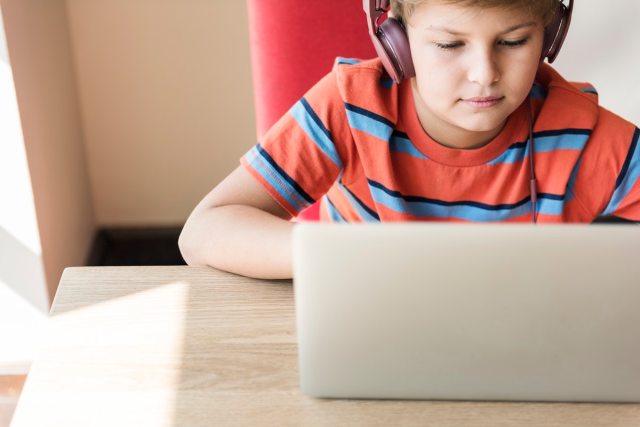
photo: Rawpixels
We plugged away for six weeks experimenting with everything from computer accessories to new work spaces. Ms. E. was in the trenches with us the entire time making suggestions and modifications. We bought headphones (Batman for him; Hello Kitty for her) that did help them both focus on the computer. We let the kids choose where they wanted to work: at the outdoor picnic table, the dining room table or the art table. We focused on their surroundings to help foster a better learning environment. But my kids still resisted getting online. And once they were virtually connected, they complained about being exhausted. Constantly. There was little we could do to manipulate the onscreen world to make it less overwhelming.
We traded online lessons for live instruction.
Just days after the new schedule changed in Sept., Ms. E. held a virtual meeting explaining the changes and urging parents to be mindful of their students’ mental well-being. She empowered parents to opt out of a class or lesson if the workload was feeling too much. I knew at once what we had to do and dashed off a message that we were going to take the next day “off” of online learning and jump in to some live lessons. It worked so well that Ms. E. offered to help me create a custom educational plan that made the leap from virtual to live lessons—and met the school’s quarterly requirements.

photo: istock
We try to capture everybody’s best hours.
My husband and I used to be night owls, but the combo of kids, COVID and, frankly, age, has us realizing we get things done faster and more efficiently when we first wake up. He typically rises around 5 a.m. to shower, eat and log on to his computer. I require a few more zzz’s, so I’m up at 6 a.m. to start my work day.
The kids start to rise at 7 a.m. At this point, my husband’s been at the grind for two hours. He takes a break to help the kids start their day. He helps them get dressed and makes them breakfast. If there is time before his first morning Zoom, he starts their morning work out with them. Their school had a genius in-person schedule pre-pandemic that kicked off each day with some outdoor activities (weather permitting). We thought it was pretty brilliant, so we’ve modeled our day to mirror what their little lives will look like once they are back in school so the leap to the real classroom will be less difficult. It also helps to get the morning wiggles out so they can more easily focus on new lessons.
My husband and I are a teaching tag-team.
I emerge from my office between 8-8:30 a..m.; by 8:30 a.m, my husband has to head back to work (a.k.a our bedroom), so he passes the torch to me. If they haven’t had a chance to run, jump and leap yet, we do this first. Getting the wiggles out before we start our school day has been paramount to having a successful day.
With the (virtual) hand-holding of literally the most amazing teacher ever, we’ve taken the awesome hands-on approach their school is famous for and implemented it in our home. We’re trying to soak up all the advantages of being house-bound by spending as much time as possible outdoors. Morning lessons, which run from 9 a.m. to 11-ish, are usually focused around building on our phonics skills (we’re embarking on blended sounds) and working on cvc sight words; we use magnetic letters to build words on our garage door and we chalk our driveway with basic sentences. Some days the kids are eager to jump from one lesson to the next, others they need a break before lunch; on those days they have free play from 11-12 p.m.
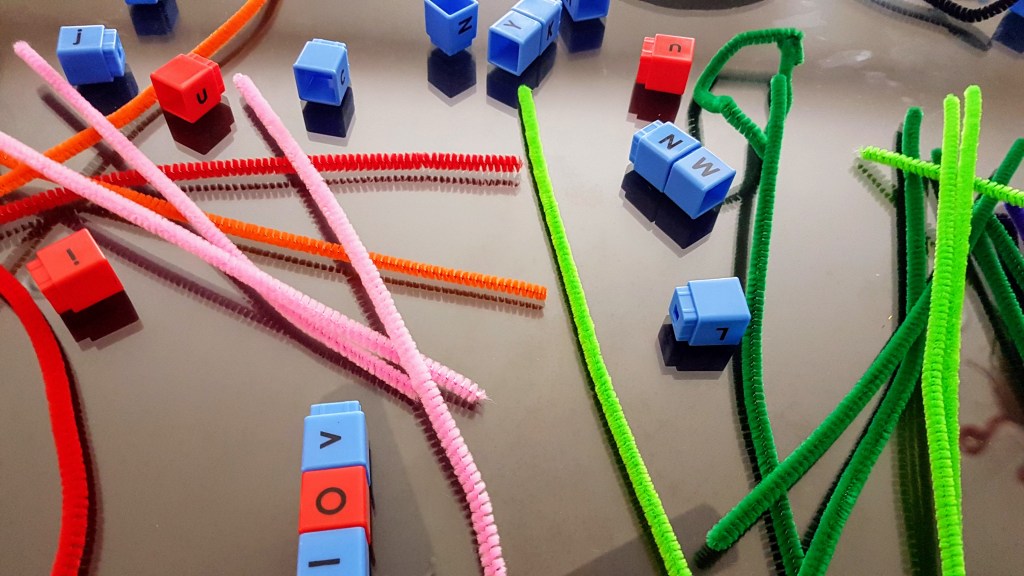
Lunchtime: Tag. My husband’s it (again).
In the perfect world, our at-home routine would mirror their school’s daily on-site schedule perfectly. But this is not a perfect world. This is 2020 and, let’s be honest, there is NOTHING perfect about 2020. So, we don’t break for lunch at 11 a.m. (per their future curriculum). Instead, we try to wait until 12 p.m. when Daddy (a.k.a. the hubs) can jump in.
Professionally, my husband is a numbers guy. But he’s also the Phonics King (a skill I never learned.). So, I lean on him to help drive these lessons home. The kids make words with letter cubes they can stack to build words, they practice sight words with Play-Doh, and complete sentences with pipe cleaners. If there is time, they squeeze in a book or two before eating lunch (thanks to Chef Daddy!). Meanwhile, I’m taking the hour to catch up on work and answer emails. If the day allows, I take a quick drive while blasting old school hip-hop (hey, it centers me).
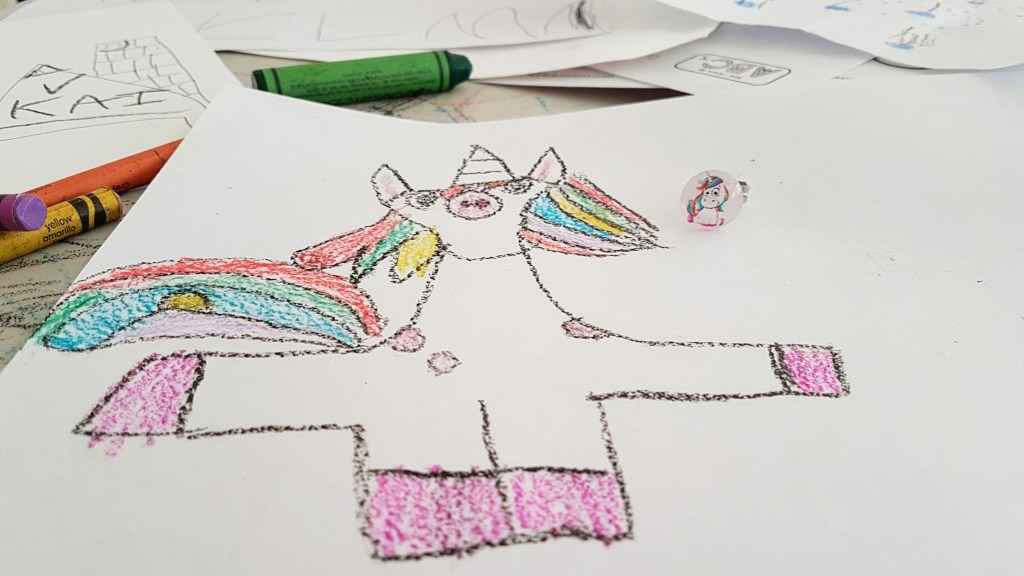
photo: Meghan Yudes Meyers
Afternoon: It’s time for Specials.
In addition to reading, writing and mathematics (our a.m. focus), we need to keep pace with what is locally known as “Specials.” This is an all-inclusive term for art, music and PE. But I’ve cast a wider net and made our afternoons about anything beyond the “3 Rs.” We try to focus these art projects and science lessons to the hours of 1-3 p.m. To kick off “Specials,” we often jump online for a quick 15 minute video.
My kids have literally the world’s best teacher. We try to “see” her everyday.
Most of the day, we are doing “live” lessons, meaning school activities and projects are 100% offline. But we want our kids to feel connected to their teacher and the school community, so we try to get the kids engaged with at least one pre-recorded video a day. They love seeing their teacher, Ms. E., explain the project of the week (a hands-on lesson that cumulatively engages all the lessons of the week). If we’ve crossed off the class project, we spend time watching a Science lesson with Ms. S. or a music video that explores the week’s theme (recently it was patterns; my daughter was inspired to write her own song with an ABBABB sequence).
The lesson plans and videos provided by the school are meant to spark the imagination. Sometimes they come with a list of materials you may want to have on-hand to get started, but often it’s up the the students to brainstorm ways they can accomplish their assignment utilizing what they have on-hand. My kids can spend hours (literally) working on a new invention for their Science class (most recently, a car with slides for doors which was created using pieces of cardboard, a toddler shopping cart for the base and lots and lots of tape) or painting a picture for their school journal. But if they finish up their Special work, I call it a day. Post-school they are free to play, but these days their free play often reinforces school lessons (they like to play “school” with their stuffed animals going over math facts and new sight words). If things are going smoothly, I can squeeze in important calls between the hours of 3-6 p.m. when they are off having fun.
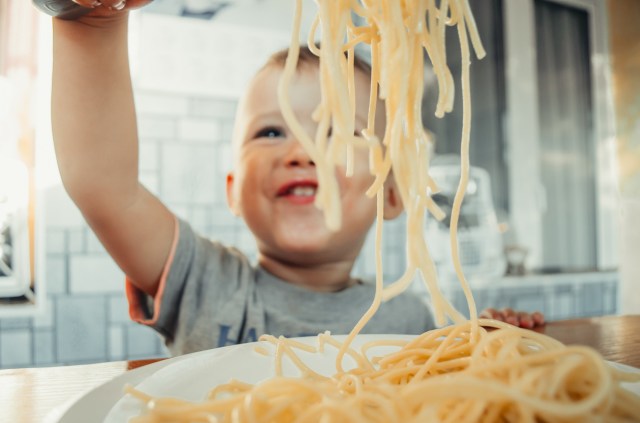
photo: istock
The Evening: A United Force
My husband takes a dinner break around 6 p.m; we’ve pushed meal time to a later hour so we can eat as a family. Dinners these days involve the path of least resistance. We’ll often support our favorite local restaurants. But in a pinch, we’re a-OK with short cuts like eggs for dinner or PB sandwiches. Healthy meals—at a communal table with family—are our primary goal.
We’re not conventionally schooling over here. So, while a strict 8-3 schedule felt cumbersome, sneaking in lessons all day long does not. Our biggest secret? We save math for last. Sometimes we’ll squeeze some problems into our day (what’s 3X3? Show me your answer in jumping jacks!), but generally we use table time to not only practice math skills, but also explore new ones. We recently leaped into multiplication while playing with a plate full of Rigatoni (hint: large, fat, tubular noodles make GREAT manipulatives). Dessert is also a great time to explore arithmetic (hello LITERAL pie charts). In general, we’ve found playing with food makes for successful math lessons!
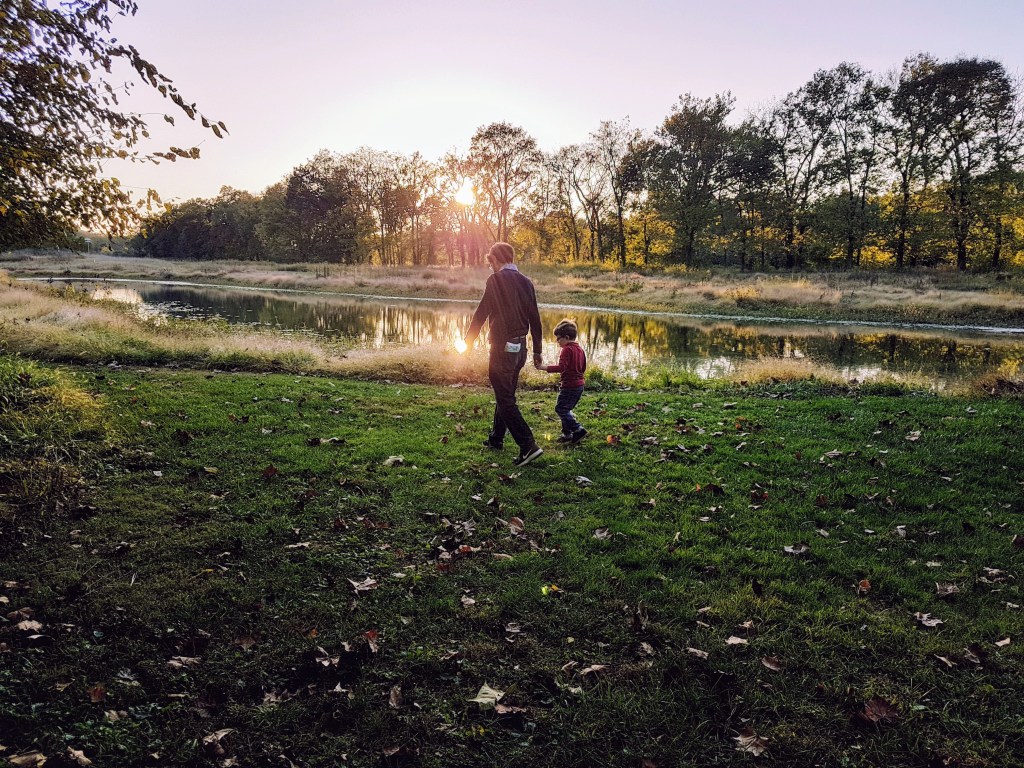
Nighttime: Calling it a Day
On our best days, we try to take a walk as a family. But my COVID-19 pounds suggest we don’t do this often enough. Personally, I like the nights we spend the after-dinner hour belting out 80s and 90s tunes at the tops of our lungs. We rock it out as a family and then it’s time for bed.
My husband tackles the 3 bedtime basics—bath time, brushing and bedtime stories—while I head back to the office. When everyone is dressed and tucked in bed I take a quick break for a good-night snuggle, hit play on their Zenimal and back to the basement—I mean office —I go. My husband retreats to his office once the kids are soundly asleep. We both burn the midnight oil. If we’re lucky, we sneak in a TV show together when we’ve buttoned up our work day.
Virtual learning didn’t work for my kids. But we’re not quite homeschooling. We’re lucky enough to have one of the best teachers in the world and probably one of the most flexible public school administrations in this country make sure that our kids were actually learning and thriving and not punching a time clock.
Interested in telling your story? Start by filling out our questionnaire here. All stories are anonymous.
—Meghan Yudes Meyers
RELATED STORIES:
Gear to Get You Through the Pandemic: Our DC Editor’s Guide
Take the Kids on a DC Scavenger Hunt
A Love Letter to DC: 10 Things We Can’t Wait to Do Again
